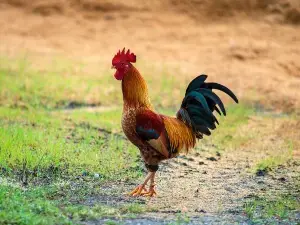
Your rooster is likely a very active and boisterous bird, all roosters are this way. Roosters take charge of leading and managing the flock and will go around stopping squabbles and keeping the peace in the flock.
But your rooster won’t be able to do much if it has a broken leg. This article looks at what to do if your rooster has a broken leg.
Table of Contents
Rooster broken leg:
Roosters can easily recover from a broken leg if the circumstances are right.
If the rooster’s leg bone breaks below the ‘knee joint’ and if this is a clean break, then there is a higher chance that the leg will be fine if treated well enough. This type of break can be treated using a splint.
If the bird’s leg breaks above the knee joint then this break is unlikely to heal.
In addition, if the bird suffers a compound break, where the bone breaks and is visible through the skin, then the bird’s broken bone has a very low chance of healing.
If the bone has a low chance of healing then you may have to amputate the bird’s leg. A bird that can’t heal a broken bone will be in great pain for the rest of its life and will have a lower quality of life because of this
Break below the knee:
Fortunately, if your bird’s bone breaks below the knee joint, and if the break is a clean break (where the bone does not break through the skin and is not displaced), then the bone has a higher chance of healing.
This is how to help the bird:
Wash your hands and wear a pair of gloves before you touch your rooster. This will keep your hands clean and keep cross-contamination from happening.
Clean the injured area using a saline solution and then use a wound ointment, or a wound spray, depending on what you have access to, on the bird’s wounds.
Wrap a clean gauze around the broken leg before adding the splint. The gauze will keep pressure sores from developing on the bird’s leg.
The gauze needs to be changed every 2-3 days during the first week of the rooster’s healing and then every 3-4 days until the bird has fully healed.
Add the splints over the gauze onto the bird’s leg, splints can be made out of popsicle sticks or tongue depressors. You’d need to size and cut the splints to fit the bird’s leg.
Make sure that the splints are large enough to cover the length of the broken bone. Also, make sure that you wrap tape over the top of the splints to keep the sharp bits from jabbing into the bird.
Wrap soft adhesive tape over the splints and then wrap masking tape over the soft adhesive tape to secure everything.
After splinting:
Keeping the bird isolated will help the bird heal, keep the bird in a cage to keep him from moving around too often. You may need to leave the bird in the cage for 1-2 weeks while its leg heals
Make sure that the bird has access to food, water, and electrolytes while in the cage. The electrolytes will help with the healing of the leg and will help the bird recover from the shock of the broken leg.
Break above the knee:
An above-the-knee break is a cause for concern.
A break above the knee will bleed more than a break below the knee making the risk of death, because of a loss of blood, quite high.
In addition, because more circulation happens above the knee, there is a greater chance of infection if a bird’s bone breaks in this area.
For these reasons, the best thing to do for a bird suffering from a break above the knee is to have the bird seen by a vet, amputate the bird’s leg, or euthanize the bird.
It is highly recommended that you amputate the bird’s leg if it starts to rot or if it has become infected. If you don’t do this, then the bird may develop gangrene or blood poisoning stemming from the broken and now infected leg.
You can choose to amputate the bird’s leg yourself, or, you can choose to have a vet do it, it is recommended that a vet do it.
On taking the bird to the vet:
Chicken bones aren’t known to heal very well. In order for a rooster’s leg to heal properly, the bones need to be alligned correctly and the bird needs to be immobilized to keep the bones from coming out of place.
If you can’t do this yourself then you’d need to take the bird to a vet or to a rehabilitation center to be treated.
If you enjoyed this article then you may also be interested in other chicken related articles. Here are some articles that you may be interested in: Chicken Walking On Hocks, Chick Walking On Hocks, Chicken Has A Broken Knee Joint, Chicken Has A Broken Ankle, Chicken Limping And Has Diarrhea

